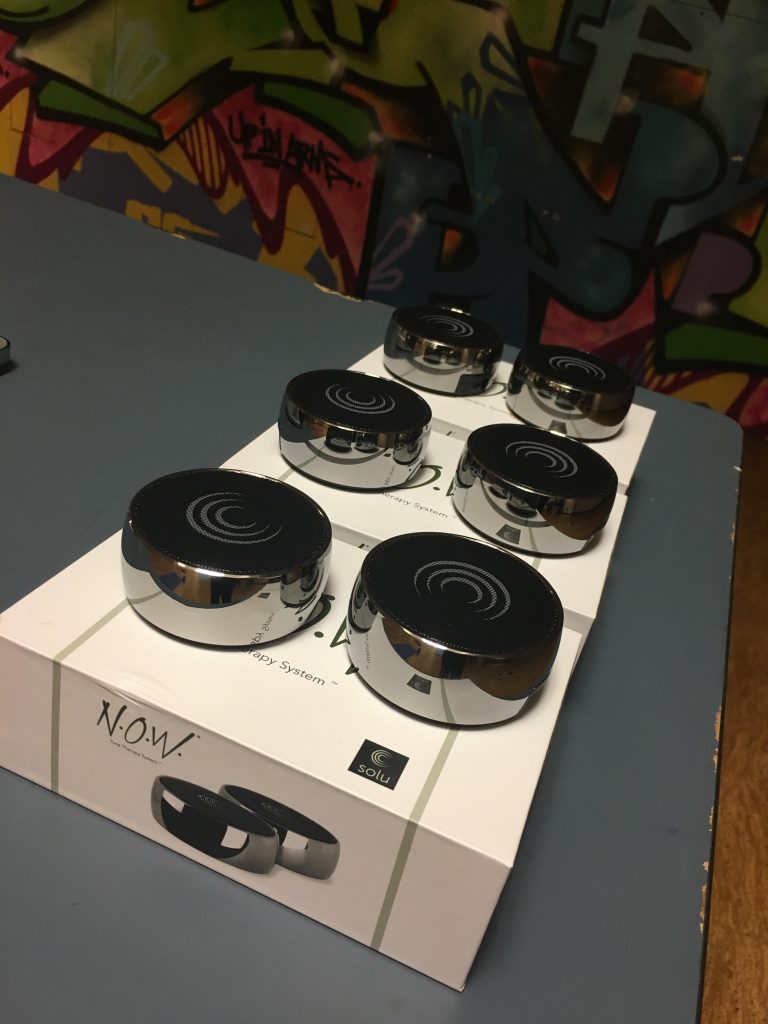
New meditation technology uses sound to quiet overactive minds
By Christie Melhorn, December 1 2017 —
I still remember how my body laid heavy but rested against the wooden floor during my first guided meditation when I was 12. My dance teacher’s voice pulled me through a lush forest conjured by my mind to find an alien with luminescent skin in a meadow. The moment brought me into a state of ease that I forgot I could reach. It felt reminiscent of being a child and having an immediate and meaningful connection with your surroundings.
Other times I’ve attempted meditating haven’t been as successful. Many of us have probably tried and failed at sitting cross-legged on the floor with closed eyes in silence, focusing on “nothing.” Wrangling away rambling thoughts and rising emotions is exhausting and frustrating, even just for a few seconds.
The common notion that meditation is synonymous with concentration can foster a clumsy relationship with it. However, sound engineer Michael Joly and intuitive health coach Alene Sibley aim to introduce meditation into people’s lives in a way that their preconceptions are less likely to interfere. They created an analog speaker system called New Origin Waveform Technology (N.O.W.) that generates specialized tones to quiet overactive minds. The company, based out of Martha’s Vineyard in Massachusetts, is currently sampling the device at institutions across North America, including at the University of Calgary through the Breathe Easy Meditation club.
N.O.W. was inspired by Joly and Sibley’s mutual interest in meditative healing and Eastern philosophy. Joly was captivated by the Stephen Mitchell translation of Lao Tzu’s Tao Te Ching, which is an ancient Chinese text about existing in harmony with the spiritual essence our world. Intrigued by the text’s theme of the formlessness of consciousness, Joly wanted to use sound — a metaphysical medium — to help others cultivate a stronger sense of their internal self.
“Lao Tzu wrote that book by being deeply in touch with his own inner-stillness and consciousness,” Joly said. “One of my favorite Tzu quotes is, ‘Stop thinking and end your problems’. I realized through my work [as an audio product engineer] that [while] listening with intention, I could not be thinking. When you’re totally present and using your perceptual facility of hearing, you can’t dwell on your perceived problems.”
The N.O.W. system includes two portable metal speakers that fit into the palm of your hand. They emit three-minute processions of resonant, brassy tones. Joly says that the sound pattern is unique with every listen and is meant to relieve anxious thought.
“We tried to make the present moment captivating and easy to sit with,” Joly said. “Mindfulness is classically defined as a non-judgmental awareness of the present moment. This give you something you can focus on instead of your thoughts.”
The Breathe Easy Meditation club uses N.O.W. to facilitate their group meditations. Club president Masha Manina says it has an engaging and positive impact.

Photo provided by Masha Manina
“It has a very grounding effect and is very calming. Since it’s just sound and not a song, it really helps tune out your thoughts,” Manina said. “It’s really nice that it’s not connected to a phone or an app. You can totally detach.”
Sibley says that limiting N.O.W.’s listening sessions to three minutes was a mindful decision.
“You’re probably going to think you’re failing if there’s an option for longer and you’re only doing three minutes,” Sibley said. “It’s a prescription for feeling bad about yourself.”
Manina says that N.O.W.’s simplicity especially benefits those new to meditation.
“All you have to do is charge [the speakers] and adjust the volume to your liking. When it’s over, it just shuts off on it’s own.” Manina said. “Three minutes is a good starting point. Sometimes when we try to get [better] at something that is so big, we need to start small — maybe just start with a few minutes, then build up to 10.”
Each session ends with a fade of the tones. Joly explains this carries great symbolic purpose.
“The fade of the tones echoes the disillusion of form in Buddhist thought — the concept that all forms come to an end — relationships, the life of a loved one, jobs,” Joly said. “The end fade is an opportunity to experience this in a safe and non-threatening way.”
Learning to meditate is challenging — especially when our minds have been paradoxically conditioned to “let go” with rigorous concentration. Forcing yourself to be calm by “thinking about nothing” is futile and there are many more effective methods of genuinely becoming so. Regardless of how readily you can achieve that, trying new meditative approaches offers insight about your mind-body connection.
The Breathe Easy club is currently distributing N.O.W. sets to members to try the three-minute meditations twice a day for seven consecutive days and assess their experience.
“We want to see how volunteers feel before and after [the week of N.O.W. meditations] and be really conscious of that change,” Manina said.
Click here to learn more about N.O.W. Technology or email breatheeasyuofc@gmail.com.
